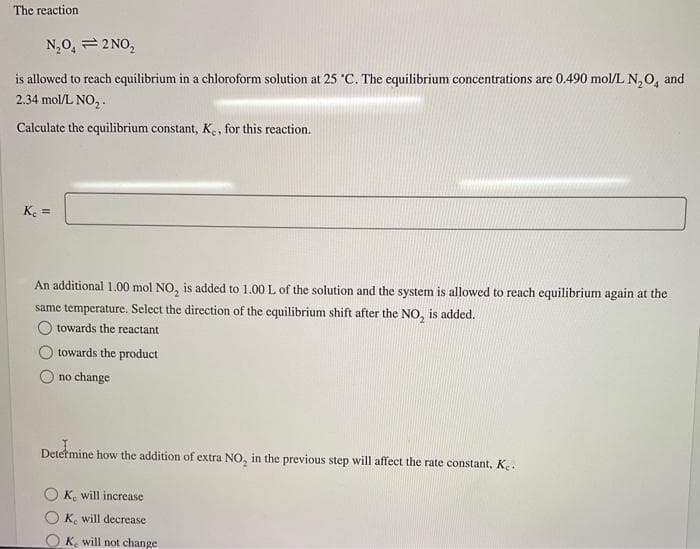The reaction. N₂0₁2 NO₂ is allowed to reach equilibrium in a chloroform solution at 25 °C. The equilibrium concentrations are 0.490 mol/L N₂O, and 2.34 mol/L NO₂. Calculate the equilibrium constant, K., for this reaction. K₂ = An additional 1.00 mol NO₂ is added to 1.00 L of the solution and the system is allowed to reach equilibrium again at the same temperature. Select the direction of the equilibrium shift after the NO, is added. O towards the reactant towards the product no change Determine how the addition of extra NO, in the previous step will affect the rate constant, K. Ke will increase Ke will decrease Ke will not change
The reaction. N₂0₁2 NO₂ is allowed to reach equilibrium in a chloroform solution at 25 °C. The equilibrium concentrations are 0.490 mol/L N₂O, and 2.34 mol/L NO₂. Calculate the equilibrium constant, K., for this reaction. K₂ = An additional 1.00 mol NO₂ is added to 1.00 L of the solution and the system is allowed to reach equilibrium again at the same temperature. Select the direction of the equilibrium shift after the NO, is added. O towards the reactant towards the product no change Determine how the addition of extra NO, in the previous step will affect the rate constant, K. Ke will increase Ke will decrease Ke will not change
Chemistry
10th Edition
ISBN:9781305957404
Author:Steven S. Zumdahl, Susan A. Zumdahl, Donald J. DeCoste
Publisher:Steven S. Zumdahl, Susan A. Zumdahl, Donald J. DeCoste
Chapter13: Chemical Equilibrium
Section: Chapter Questions
Problem 23Q: Consider the reaction 2N2O(g) + O2(g) 4NO(g) Suppose the system is at equilibrium, and then an...
Related questions
Question
![Determine how the addition of extra NO₂ in the previous step will affect the rate constant, Ke
OK, will increase
K, will decrease
OK, will not change
Calculate the equilibrium concentrations of N₂O, and NO₂ after the extra 1.00 mol NO₂ is added to 1.00 L of solution.
[N₂O₁] =
[NO₂] =
mol/L
mol/L](/v2/_next/image?url=https%3A%2F%2Fcontent.bartleby.com%2Fqna-images%2Fquestion%2F8fa072c0-a0c4-4988-9688-edbe18b8bc58%2Fa4e414ca-66e7-49cd-8af2-a37b3d5f7ab9%2Fxl7lfj6_processed.jpeg&w=3840&q=75)
Transcribed Image Text:Determine how the addition of extra NO₂ in the previous step will affect the rate constant, Ke
OK, will increase
K, will decrease
OK, will not change
Calculate the equilibrium concentrations of N₂O, and NO₂ after the extra 1.00 mol NO₂ is added to 1.00 L of solution.
[N₂O₁] =
[NO₂] =
mol/L
mol/L

Transcribed Image Text:The reaction.
N₂0₁2 NO₂
is allowed to reach equilibrium in a chloroform solution at 25 °C. The equilibrium concentrations are 0.490 mol/L N₂O, and
2.34 mol/L NO₂.
Calculate the equilibrium constant, K., for this reaction.
K₂ =
An additional 1.00 mol NO₂ is added to 1.00 L of the solution and the system is allowed to reach equilibrium again at the
same temperature. Select the direction of the equilibrium shift after the NO, is added.
towards the reactant
towards the product
no change
Determine how the addition of extra NO, in the previous step will affect the rate constant, Ke
Ke will increase
Ke will decrease
Ke will not change
Expert Solution
This question has been solved!
Explore an expertly crafted, step-by-step solution for a thorough understanding of key concepts.
This is a popular solution!
Trending now
This is a popular solution!
Step by step
Solved in 3 steps with 2 images

Knowledge Booster
Learn more about
Need a deep-dive on the concept behind this application? Look no further. Learn more about this topic, chemistry and related others by exploring similar questions and additional content below.Recommended textbooks for you

Chemistry
Chemistry
ISBN:
9781305957404
Author:
Steven S. Zumdahl, Susan A. Zumdahl, Donald J. DeCoste
Publisher:
Cengage Learning

Chemistry: The Molecular Science
Chemistry
ISBN:
9781285199047
Author:
John W. Moore, Conrad L. Stanitski
Publisher:
Cengage Learning

Principles of Modern Chemistry
Chemistry
ISBN:
9781305079113
Author:
David W. Oxtoby, H. Pat Gillis, Laurie J. Butler
Publisher:
Cengage Learning

Chemistry
Chemistry
ISBN:
9781305957404
Author:
Steven S. Zumdahl, Susan A. Zumdahl, Donald J. DeCoste
Publisher:
Cengage Learning

Chemistry: The Molecular Science
Chemistry
ISBN:
9781285199047
Author:
John W. Moore, Conrad L. Stanitski
Publisher:
Cengage Learning

Principles of Modern Chemistry
Chemistry
ISBN:
9781305079113
Author:
David W. Oxtoby, H. Pat Gillis, Laurie J. Butler
Publisher:
Cengage Learning

World of Chemistry, 3rd edition
Chemistry
ISBN:
9781133109655
Author:
Steven S. Zumdahl, Susan L. Zumdahl, Donald J. DeCoste
Publisher:
Brooks / Cole / Cengage Learning

Introductory Chemistry: A Foundation
Chemistry
ISBN:
9781285199030
Author:
Steven S. Zumdahl, Donald J. DeCoste
Publisher:
Cengage Learning

Chemistry & Chemical Reactivity
Chemistry
ISBN:
9781133949640
Author:
John C. Kotz, Paul M. Treichel, John Townsend, David Treichel
Publisher:
Cengage Learning